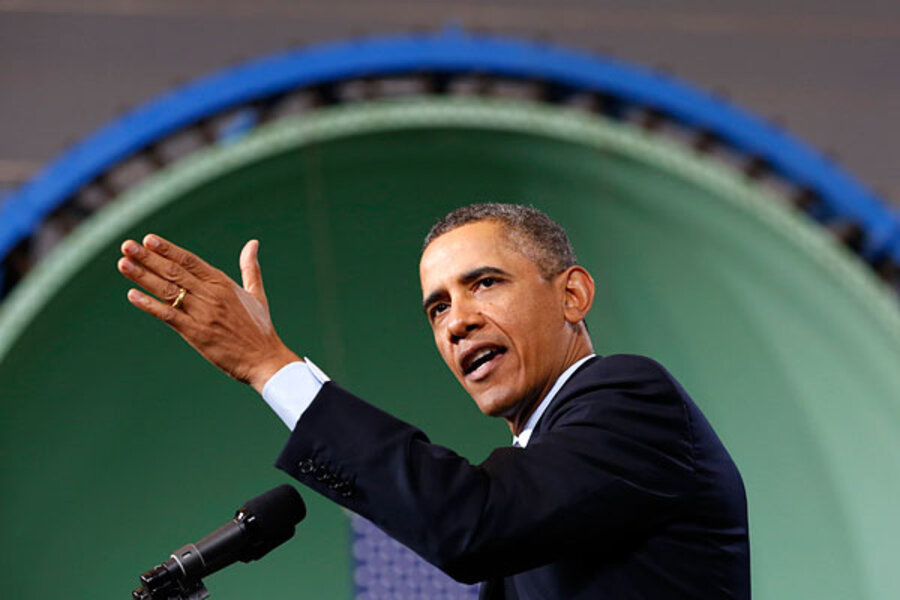Obama's plan to replace the 'sequester': Does the math add up?
Loading...
President Obama has proposed a plan to avoid the much-loathed “sequester” that’s scheduled to kick in Friday, imposing significant spending cuts on most programs in the federal government.
His plan is to replace the sequester's $1.2 trillion in across-the-board cuts over the next 10 years with targeted cuts and tax reforms that would cut the deficit by $1.5 trillion over the same period. The White House summarized the details of his plan to get to that $1.5 trillion number earlier this month.
Whether his plan is politically feasible is one thing – Republicans would have to swallow his proposal to close some tax loopholes for wealthy households. But increasingly there are questions about the economics of his plan, too.
Is $1.5 trillion enough?
Ultimately, Mr. Obama's goal is to get the US to $4 billion in deficit reductions over the next 10 years – a sort of magic number laid out by the 2010 Simpson-Bowles deficit commission. Obama does this by pairing his new proposal with $2.5 trillion in deficit savings over the next 10 years already approved by Washington, including spending caps from the 2011 Budget Control Act, tax hikes from the "fiscal cliff" deal, and lower interest payments tied to those changes.
The problem is, some economists say that, two years on, the $4 trillion goal is not enough anymore.
“President [Obama] has set the target for deficit reduction far too low,” commented the Committee for a Responsible Federal Budget after Obama laid out his target two weeks ago. “He failed to mention that the $4 trillion economists were calling for after the Simpson-Bowles report is now more like $6.7 trillion today. By that measure, our debt problems are far from solved.”
As Democrats and Republicans prepare for their next round of high-stakes budget bargaining, the $4 trillion question is an important one. If the two sides are going to replace the automatic spending cuts of the sequester with something new, a central part of the job is deciding how much total deficit reduction is necessary.
Obama's $1.5 trillion plan to replace the sequester calls for about $400 billion in savings from health-care entitlement programs, $200 billion in discretionary spending cuts, and $200 billion in savings from mandatory programs (other than health care), including farm subsidies. On the tax revenue side, his main goal is to reap $580 billion from closing tax breaks for wealthy households. Interest on the debt would go down as a result of those changes.
But the broader debate over whether $1.5 trillion is enough comes down to two viewpoints: Should a new deal "stabilize" the debt or steer it on a downward track?
In the end, $4 trillion in deficit savings over the next decade would leave the national debt at the same place it is now: about 73 percent of gross domestic product (GDP).
Critics see a few problems with that.
One is that, by some measures, the national debt is actually higher – above 100 percent of GDP if you use a “gross debt” figure that includes the cost of obligations to fund Medicare and Social Security.
A second problem is that stabilizing the debt isn’t necessarily good enough. It doesn’t leave much room for maneuver in hard times, such as a renewed bout of recession or a war.
Third, stabilizing debt over a 10-year window isn’t the same as stabilizing it longer term. Budget forecasters see the debt continuing to rise thereafter, largely due to health-care programs and rising debt-service costs.
Ben Bernanke, the Federal Reserve chairman, urged Congress this week to put the debt on a downward path. He implied the goal should be 40 percent of GDP, the level where the debt generally hovered for decades prior to the 2008 financial crisis.
Alan Simpson (R) and Erskine Bowles (D), the chairmen of the deficit commission, similarly call for steering the debt level downward, and the Committee for a Responsible Federal Budget agrees. It says $2.4 trillion in additional deficit reduction – as opposed to Obama's $1.5 trillion – is “the minimum needed to put the debt on a clear downward path relative to the economy.”
Others say the $4 trillion total goal isn’t a bad one.
It brings deficits below 3 percent of GDP by 2015, which arguably strikes a good balance between fiscal responsibility and not hurting the economic expansion by imposing too much austerity too soon. Additional deficit reduction may be helpful if it can be done without harming economic growth, adding to poverty, or increasing overall health-care costs in the economy, says Richard Kogan of the left-leaning Center on Budget and Policy Priorities.
Obama says he’s ready to bargain in good faith, albeit from the standpoint that additional deficit reduction should include tax revenue as well as more spending cuts. Conservatives say that the president has failed to lead.
But Steve Bell, a budget analyst at the Bipartisan Policy Center who served for years as a Republican congressional staffer, says that these questions are not easy for Republicans, either. He says conservatives and liberals alike are aware of the risks of a voter backlash from tinkering with Social Security and health-care programs, which are the biggest driver of projected deficits in the long run.
"It's been this strange non-dialogue," he says.








